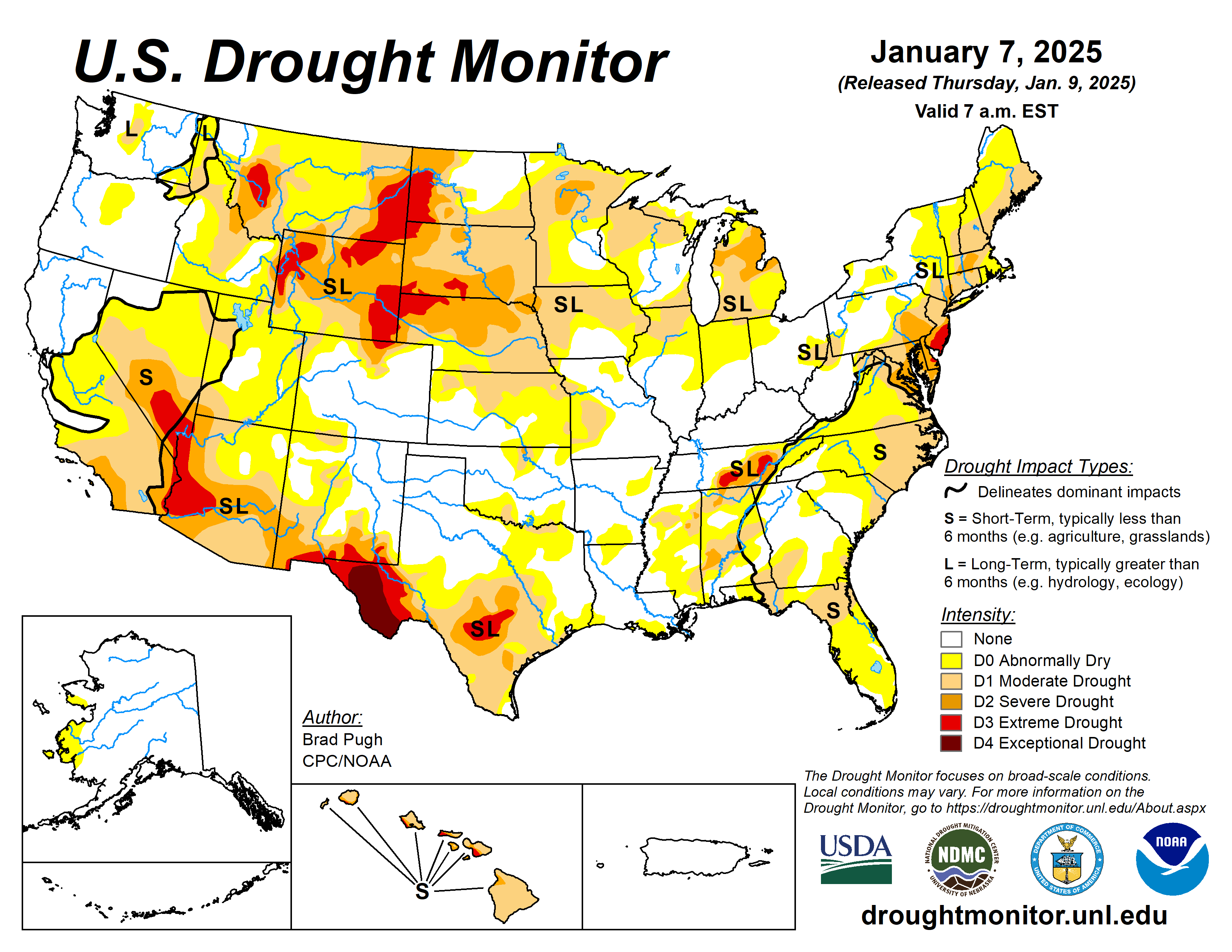On Jan. 4 and 5, a low-pressure system developed across the central Great Plains and then tracked eastward to the Mid-Atlantic.
Along its track, widespread precipitation (1 to 2 inches, liquid equivalent) was observed throughout eastern Kansas, Missouri, the Ohio and Tennessee Valleys, Central Appalachians, and Mid-Atlantic.
Total snowfall amounts were near or more than a foot in portions of these areas. This winter storm also resulted in freezing rain for the Ohio Valley and parts of Virginia and West Virginia. Drought improvements were generally made to portions of the central and eastern United States where precipitation amounts exceeded 1 or 1.5 inches, liquid equivalent.
After the winter storm exited the East Coast, an arctic air outbreak overspread the eastern two-thirds of the lower 48 states. A favorable start to the wet season coupled with above-normal snowpack supported a decrease in drought coverage across the Pacific Northwest. Conversely, drought worsened for southern California and the Southwest.
The U.S. Drought Monitor is jointly produced by the National Drought Mitigation Center at the University of Nebraska-Lincoln, the U.S. Department of Agriculture and the National Oceanic Atmospheric Administration. (Map courtesy of NDMC.)
South
Based on 30 to 120-day standard precipitation index, 28-day streamflow, and soil moisture, a 1-category degradation was made to portions of the Edwards Plateau of Texas.
SPIs at various time scales and soil moisture supported a 1-category degradation as well for parts of the Rio Grande Valley. Heavy rainfall during late December supported additional improvements across southeastern Texas.
Although precipitation was lighter this past week, the lack of any support among the indicators for D0 and D1 led to improvements to much of Arkansas.
Midwest
More than 1 inch of precipitation (liquid equivalent) supported a 1-category improvement across northwestern Missouri. Recent precipitation (around 0.5 inch, liquid equivalent) along with improving SPIs at various time scales and with support from 28-day average streamflow above the 20th percentile, moderate drought (D1) was reduced to abnormal dryness (D0) for portions of Illinois and Indiana.
D1 was maintained for the northeast corner of Indiana which is consistent with SPIs dating back to 120 days. Beneficial precipitation and cooler seasonal temperatures led to a decrease in drought coverage and intensity for much of Ohio. Although soil moisture has improved in recent weeks, it remains low especially across southeastern Ohio. 28-day average streamflows are near to above average for most of western to central Ohio.
High Plains
Based on 30 to 60-day SPI along with a lack of early season snowpack, a 1-category degradation was made to southwestern Colorado.
Farther to the north across northwestern Colorado, improving snowpack resulted in a minor reduction in abnormal dryness (D0). Southwestern Nebraska has received little to no precipitation during the past seven weeks, prompting an expansion of D0.
In addition, above-normal temperatures during the late fall and into the early winter exacerbated increasing short-term dryness. Heavy precipitation (more than 1 inch, liquid equivalent) for this time of year resulted in a 1-category improvement to northeastern Kansas. No changes were made to the Dakotas and early January is one of the driest times of the year.
West
A dry start to the winter and using 90-day SPI and soil moisture, moderate drought (D1) was expanded across southern California.
The NDMC short-term blend, 90-day SPI, and many 28-day average streamflows below the 10th percentile supported the addition of severe drought (D2) to portions of southern California. The Santa Ana winds during early January are likely to exacerbate the worsening drought conditions.
Consistent with the NDMC short-term blend along with 30 to 120-day SPI, D2 was expanded for portions of southwestern New Mexico. Based on water year to date (WYTD: Oct. 1 to Jan. 6) precipitation averaging above normal and snow water equivalent above the 80th percentile, a 1-category improvement was made to a small part of northwestern Montana.
This 1-category improvement is also supported by NDMC drought blends and SPIs at various time scales. SWE was highly variable for the Sierra Nevada Mountains and below-normal across the Four Corners region.
Looking ahead
A low-pressure system is forecast to develop along the western Gulf Coast by Jan. 10 with a rapid eastward track offshore of the Mid-Atlantic one day later. A large area of 1 to 2.5 inches of rainfall is expected for eastern Texas and the lower Mississippi Valley, with accumulating snow for the southern Plains.
High elevation snow is forecast to the northern Rockies on Jan. 10 and 11. Farther south across California, dry weather is likely to persist through mid-January. On Jan. 13, another Arctic high is forecast to shift south from Canada to the Great Plains.
The Climate Prediction Center’s six- to 10-day outlook (valid Jan. 14 to 18) favors below-normal temperatures for a majority of the lower 48 states. The largest below-normal temperature probabilities (exceeding 80%) are forecast for the Southeast.
An increased chance of above-normal temperatures is limited to the Dakotas and Minnesota. Below-normal precipitation is most likely across the Pacific Northwest, Great Basin, and much of California. Elevated above-normal precipitation probabilities are forecast for the Southwest, Texas and High Plains.
Brad Pugh is with the National Oceanic Atmospheric Administration and the Climate Prediction Center.




